
A few years ago, a short-lived controversy stormed through museum circles when some unorthodox museum directors mounted exhibitions of high fashion design. The resistance to the idea was noisy. "It isn't art!" was the cry. Because fashion design was deemed frivolous by traditionalists, the notion of major museum shows for haute couture was largely beneath consideration.
The trouble was that the public came in droves. People who knew little about the fine arts arrived at these exhibitions and, mysteriously, museum membership began to rise. One of John Buchanan's first exhibits after taking the helm at The Fine Arts Museums of San Francisco showed the work of Yves Saint Laurent, and was a smash hit. It was such an artistically distinguished show that the quibbles against it became circumspect murmurs. During his tenure, Buchanan (who, very sadly, died this December) increased The Fine Arts Museums' membership by 70 percent. New members joined old ones at such exhibitions as "Tutankhamun and the Golden Age of the Pharaohs" in 2010, "Picasso: Masterpieces From the Musée National Picasso, Paris" in 2011 and the amazing 2012 "Masters of Venice: Renaissance Painters of Passion and Power From the Kunsthistorisches Museum, Vienna," among many, many others.
Now, even the murmurs seem to have been disregarded altogether. Such exhibits are regularly mounted in major museums around the world, so that fashion has joined other once-sniffed-at endeavors (novels, jazz, movies, printmaking, still photography, rock and roll and The Blues, to name a few) as a legitimate art form. Museum-goers continue to flock to these shows and to purchase memberships that allow them entry to other exhibits, including (very importantly) those that feature traditional painting and sculpture.
A recent New York Times article by Suzy Menkes spells it out in clear terms. "There is no doubt that fashion has become the big winner and its exhibitions money spinners. At any given moment there are at least a dozen museums across the world offering major fashion displays... "
Happily, the work in many of these shows is of exceptional quality.
The Jean Paul Gaultier exhibit now at The de Young Museum in San Francisco (through August 19) is one. Gaultier is most famous for his costume designs for Madonna's 1990 Blond Ambition Tour. Madonna's performances were controversial, to say the least, the clashing religious and sexual imagery and on-stage shenanigans causing a very big stir. Gaultier's designs were a large part of that, and they are richly represented at this show.

Body corset worn by Madonna, Blond Ambition World Tour, 1990. © Emil Larsson. Used courtesy of The Fine Arts Museums of San Francisco
But if, having seen just those designs, you turned around and left, you would miss the extraordinary variety of ideas that Gaultier has demonstrated throughout his career, and his exceptional -- if often in your face -- taste. This is a very large exhibition, and there are hundreds of things to see. To give the exhibit its real due would take a viewer several days, if he/she were to truly study the intricacy of Gaultier's designs and the inventiveness with which he displays them.
A simple gold dress, perfect for an elegant party, is most notable for its simplicity.
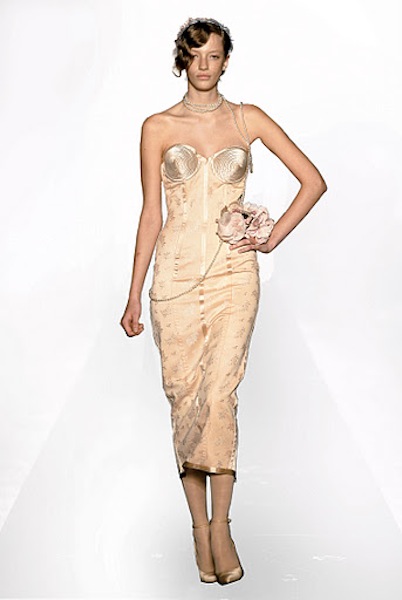
Dada collection. 1983. © Patrice Stable/Jean Paul Gaultier. Used courtesy of The Fine Arts Museums of San Francisco.
A very formal gown, with so many swatches of cloth falling here and there in different directions, would tempt you, were you to encounter it at the opening night of the opera, to study the dress first, the woman wearing it second.
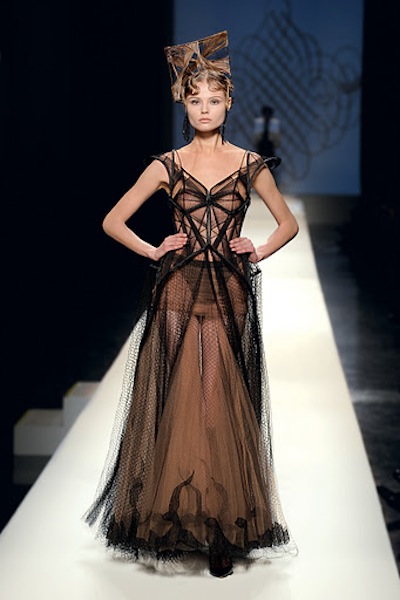
Calligraphy collection. 2009. © Patrice Stable/Jean Paul Gaultier. Used courtesy of The Fine Arts Museums of San Francisco.
A mini-dress that appears to be made of beige feathers, with a hat that looks to be designed from sharply sculpted chocolate, would look just terrific on a young Diana Ross.
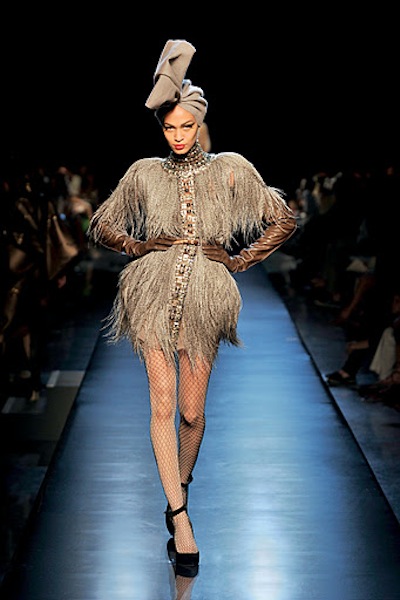
Parisiennes collection. 2010-2011. © Patrice Stable/Jean Paul Gaultier. Used courtesy of The Fine Arts Museums of San Francisco.
A long gown owes a profound artistic debt to Gustav Klimt, and this one moves, while Klimt's designs, as gorgeous as they are, are frozen in time.
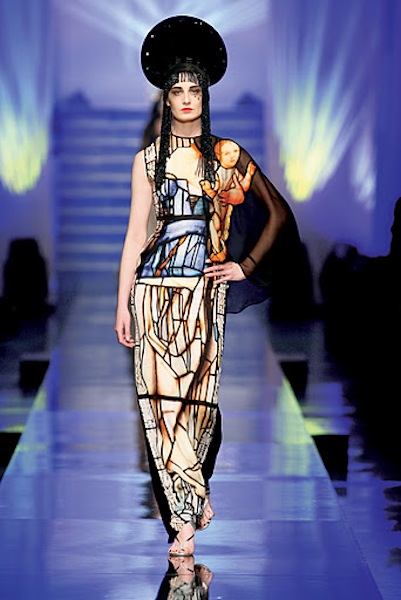
Virgins (or Madonnas) collection. 2007. © Patrice Stable/Jean Paul Gaultier. Used courtesy of The Fine Arts Museums of San Francisco.
One of the real pleasures of the exhibit is the manner in which various collections are differentiated one from the other by their unusual placements in the same large room (and there are several large rooms). One collection will be quite different from another, and the changes are easy to follow because of the way they are staged. Also, in a fine gesture to light-hearted comedy, video projections of the faces of several speaking models -- including, in the very first room, that of Gaultier himself welcoming the visitors -- appear on the faces of individual mannequins. So, they seem to be speaking to you, and watching you, as you walk by. That these mannequins are also wearing startlingly beautiful or aggressive Gaultier clothing makes the illusion downright fun.
Not everything is perfect. Gaultier's clothing for men, for example, too frequently looks like clothing for women. A business suit appears perfect for your appearance before a congressional sub-committee, except for the gown-like drapery that flows down one side of the entire ensemble, appearing a little like half of a corporate-correct pin-striped burka. We know these suits are intended for men because, in the exhibit, the mannequins wearing them have beards. It's all very humorous, but the design basically doesn't cut it.
And, of course, there is the 1994 Raw and Refined collection.
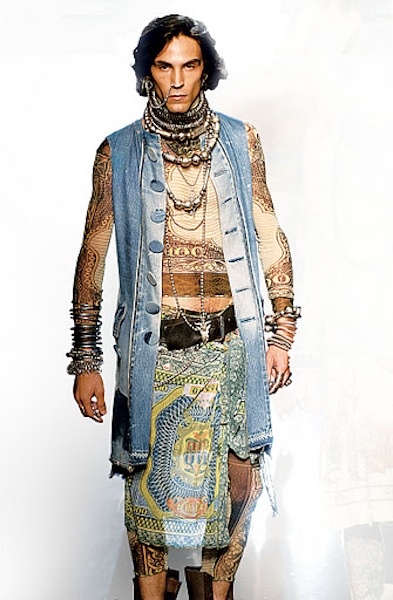
Raw and the Refined. 1994. © Patrice Stable/Jean Paul Gaultier. Used courtesy of The Fine Arts Museums of San Francisco.
It's hilarious, but silly.
This is a minor complaint. Gaultier's broad artistic reach, his profound inventiveness and adventuresome selection of materials and colors and the brightly complicated turns of line that he brings about in so many of his designs, make this show very worth seeing.
Terence Clarke's new story, "Ernesto & Julietta", is available from Amazon.com.
